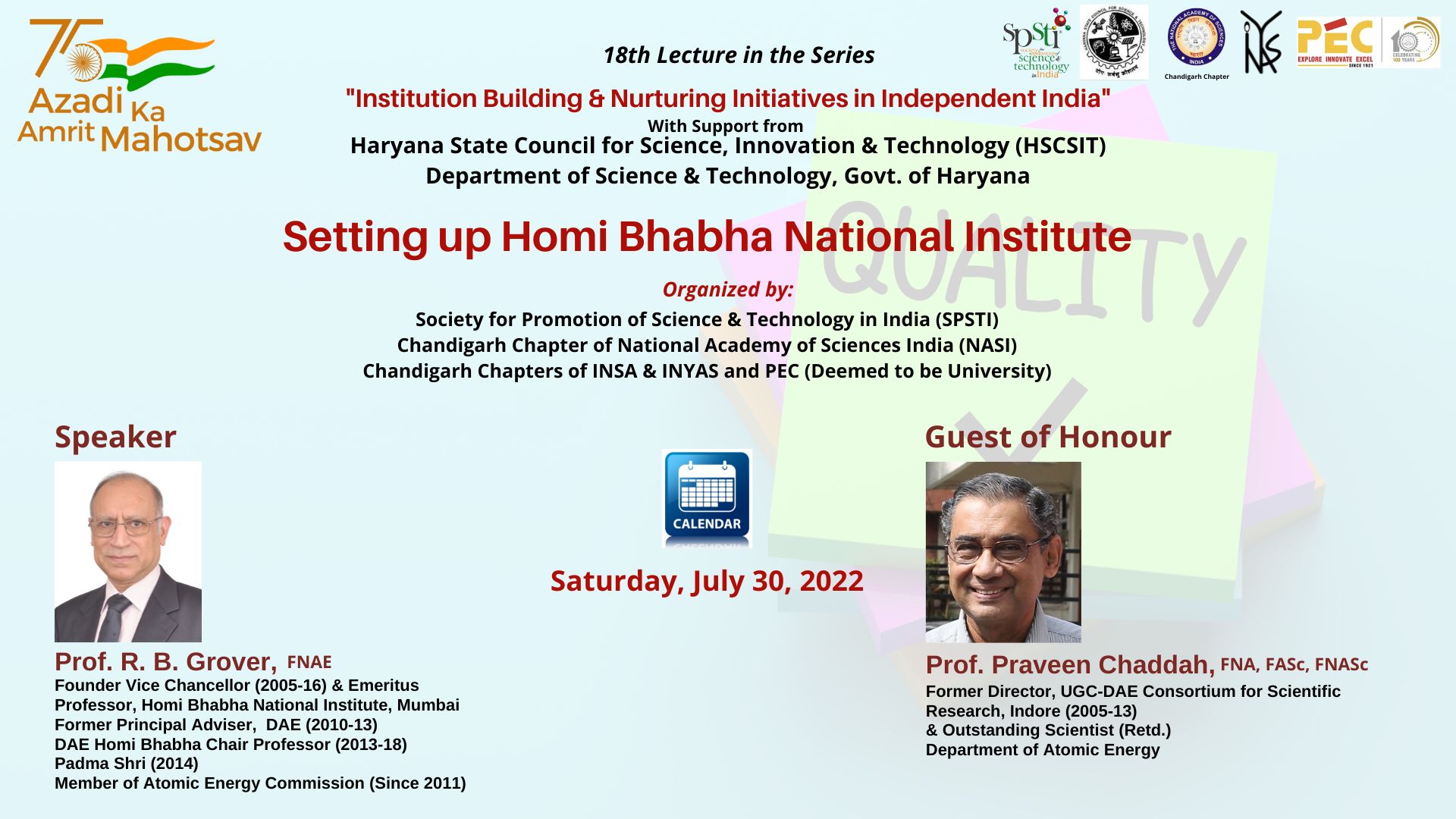The Society for Promotion of Science & Technology in India (SPSTI) organised a lecture on ‘Setting up of Homi Bhabha National Institute’in association with Chandigarh Chapters of NASI, INSA, INYAS and PEC (Deemed to be University), with support from Haryana State Council for Science, Innovation & Technology (HSCSIT), Dept. of Science & Technology, Govt. of Haryana. It was streamed live at 11.00 am on July 30, 2022 through Zoom and Facebook. This was the eighteenth lecture of the Web-series: Institution Building and Nurturing Initiatives in Independent India. The lecture was delivered by Padma Shri Prof. R. B. Grover.
Padma Shri Prof. R. B. Grover was Founder Vice-Chancellor & Emeritus Professor at Homi Bhabha National Institute, Mumbai delivered the lecture. He was Former Principal Adviser, DAE and DAE Homi Bhabha Chair Professor. He is also Member of Atomic Energy Commission since 2011. He delivered the talk on ‘Setting up of Homi Bhabha National Institute’ which is a “deemed to be university” and a grant-in-aid institution of the Department of Atomic Energy and nurturing many academic programmes. He shared the proposal to set up HBNI was taken up in 2003 and was submitted to UGC in 2004, for which accreditation was obtaind in June 2005. To bring together eleven eminnent institutions in a single framework a distributed framework for governance was devised. HBNI is ranked second in India in Nature Index-2022 and ranks 216 globally.In 2009, HBNI made presentation to MHRD which constitutted a committee to examine all deemed universities on nine parameteres and HBNI was placed under ‘B’ category. In 2012 HBNI made another presentation and was than place under the categry ‘A’.
He talked about the idea of univesity and university mission which included teaching, research and service to society and industry. He talked about the Radhakridhanan report whose focus was education but it also touched uopn issues related to researchand importance of linkages between universities, and research and development institutions. He mentions Kothari Commission which states ‘Indian problems are not seen in their concretness and particularly and as a result, techniques and theories are not adopted to Indian situation’. The latest National Education Policy 2020 also focuses on developing a skilled nation that can find robust solutions to its own problems and implemets the solutions. The changing science and technology policy are also fcussing towards the same.He shared HBNI is an attempt to create an atmosphere that nurtures intellectual fusion of theroy and practice, inculcates healthy respect for post-academic research, and encourages the building of instruments and facilities in the country. Only this approach can realise the Bhabha’s dream of powering Indian industry with science and technlogy base (developed as well as adopted) in the country. He further talked about the reationship of science and technolgy. He said technology is knowledge. Technology is power. Until ‘recent times’, technology was developed by inventors based solely on prior technical knowledge. He quoted Homi Bhabha, who said “the success of modern technology have been so great and its impact on life and society so powerful, that one is apt to forget that technology in a broad sense, meaning by that ‘knowledge of techniques’, has existed for tosands of years and determined the course of history”. Prof. Grover said there had been distance between science and technology as science was considered by elites while technology by people dependent on it for the sustenance. But the shift in this relationship started duirng 19th century, with the synthesis of aspirin, that made the chemical industry realize tha value of reserch dedicated to technological work. Despite many such developments, many scientists continued to consider engineers as second-rate minds. By 1900, engineering became a complex system of knowledge and this trend continues and engineering science is now at par with natural sciences. There has been strong relationship between pysical sciences and civil, mechanical and electrical engineering, chemistry and chemical engineering. The same is happening in the case of life science and corresponding technologies.Science and technology has multiple facet relationship. Accelaration in the rate of knowledge production, squeeze on funding of research and scrutiny by society has led to new methods of knowledge production. He shared that for doctoral eduation thare should be change in the intellectual climate in the unversity to develop a healthy respect for engaging in professional practice with scholastic skills and moral sensitivity. Knowledge productionis now a distributed activity due to new institutional settings and work places are store-houses of knowledge and generating and disseminating knowledge.
He summarised by saying quest for knowledge and inspiration for use and exist independently as well as simultaneously. The relationship between science and technology is not hierarchical, they are intertwined and the progress in one depends on itself and the other. There is need for mutual respect between academicians and industrial counterpart for nurturing innovation. He concluded the session mentioning a quote from speech by Bhabha delivered at the International Council of Scientific Unions in 1966 stating “If Indian industry is to take-off and be capable of independent flight, it must be powered by science and technology based in the country”.
Prof. Praveen Chadha, Former Director, UGC-DAE Consortium for Scientific Research, Indore and Outstanding Scientist (Red.), Department of Atomic Energy was Guest of Honour on the occasion, introduced by Prof. Alek Banerjee, UGC-DAE Consortium for Scientific Research.Also present on the occasion were Prof. Arun K. Grover, former Vice Chancellor of Panjabi University, Prof. Kaya Dharamvir, General Secretary, SPSTI, Prof. Anand Bachawat, IISER, Mohali, Prof. K. K. Bhasin, Secretary NASI and many other eminent scientists. The session was much appreciated by the audience and followed with lively questions and discussion.

